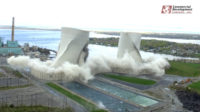The Nanticoke coal plant, once the largest in the world, stopped burning coal in 2013, but its 655-ft-tall twin chimneys stood like beacons on the north shore of Lake Erie in Canada’s Ontario province—until the end of February.
Ontario eliminated coal-powered generation four years ago. On the morning of Feb. 28, the two Nanticoke towers were felled in a controlled demolition by Delsan-AIM Environmental Services Inc. About four months of prep work culminated in “20 seconds of glory,” says Paulo Monteiro, health and safety manager at Delsan-AIM.
Prior to the explosions, Delsan-AIM spent four months preparing the site. Each chimney housed four 610-ft stacks with steel flues that sat on 30-ft concrete bases. The inside of the flues had to be cleaned of residual coal dust, and extraneous material had to be removed.
A team of engineers then calculated where and how big to make the “mouths,” or notches, that allow the towers to tumble.
Each notch was about 20 ft wide and 10 ft high. A back cut was then made opposite the mouths, leaving two side “legs” to support the chimneys. Holes were drilled to place the dynamite. About 400 to 500 lb of dynamite was used for each of the two stacks.
Monteiro would not reveal the exact number of placements. Each company has its own carefully guarded techniques for bringing down chimneys, he says.
The chimneys were then wrapped in chain link fencing and fabric to reduce shrapnel. When everything was in place, the explosive charges knocked the legs out from the towers, and they fell.
Monteiro would not say how much Delsan-AIM was being paid for the demolition job, but he did say the salvaged steel would bring in “hundreds of thousands of dollars” for the company. Once cleared, the site will be used for a solar farm.




Post a comment to this article
Report Abusive Comment